One of the most asked questions that I get here at The Village Prepper and the many forums that I frequent is: what are the most valuable skills a new prepper or survivalist should learn?
Skills, in general, are more important than gear and although talking about gear is fun, gear is there to supplement well-practiced skills.
We as a civilization have put ourselves at a disadvantage when it comes to surviving in the outdoors. Technology has continued to draw our attention away from our need to be in touch with nature.
We have made it easy to heat and cool our homes and get the food we need to survive. It is easy to become complacent, I wrote an article on this very subject and our issues with normalcy bias.
- But what if the power goes out or when the supply lines come to a halt?
- What if you are forced to bug out and head for the hills?
- What will you do if something happens while you are at work and you have to get home on foot?
The specific skills or gear you need will always vary depending on your location and climate, but the skills listed below are necessary for just about anywhere you live. In this article I am just highlighting six of the top skills I think you should learn. I will cover each skill in-depth in future articles.
Don’t just try these skills once and call it good, you should practice these skills any chance you get. Remember, things become much more difficult when you are under stress so practice often.
Building a Survival Shelter
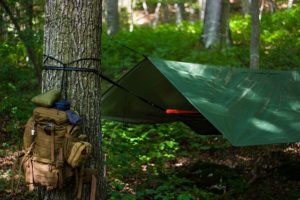
Depending on where you are and the type of weather you may experience in your area, building a shelter is at the top of the list.
The type of shelter you choose to build will depend heavily on the supplies you have at your ready. Although living in the city has its issues when it comes to survival, when it comes to shelter, it has its perks. In an SHTF situation, you can find abandoned buildings or other structures you can use for shelter.
If you are in the wilderness, you will need to learn to build a shelter, and the colder climates the higher the priority a shelter will be.
In its basic form, a shelter could just be debris piled over some limbs (i.e.: a debris shelter). This is a short-term option, but it could save your life in cold and rainy weather. Be sure to insulate the ground the best you can with leaves or pine needles.
There are many different types of shelter you could build but here are a few of the most popular.
- A-Frame Shelters
- Lean-To Shelter
- Debris Hut
- Snow Cave in Colder Climates
I will cover these types of shelters in detail in a future article.
If building a shelter out of natural materials is not an option, you can always carry your shelter with you. If you have access to an ultralight backpacking tent or a good tarp and 550 cord, this would save you time and energy if you need emergency shelter.
I always keep a small two-man tent in my bug-out vehicle and a tarp and cordage in my get-home bag (GHB) for this reason. Not because I may need to bug out, but because I may need to get home if a disaster hits, and that could take days.
Survival Shelter is Dependent on Location, Location, Location
First things first though, let’s find the best place to build our structure. Choose a level spot that is on higher ground. Build far away from any sitting water or flowing creeks and flood-prone areas. Look up and make sure there are no loose branches (widow makers) that could come down in high winds.
Building a Fire for Survival
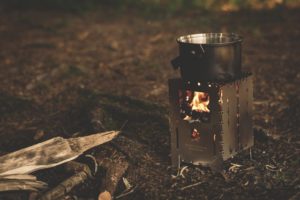
Learning to build a fire with nothing but what you find on the ground is an extremely hard skill to learn. In my experience, I have successfully started a fire with a bow drill about one in five times. It depends so much on the wood, climate, and practice.
If you are like me, I tend to get a bit impatient with these kinds of things and that is one of the reasons why I carry multiple ways to start a fire on me. I also carry dry tinder because there is no guarantee you will find something dry that will burn long enough to get a fire started in damp weather.
There are several different fire starting tender for sale and I have found the UST WetFire Tinder to be great for starting fire in wet weather. They stay lit for a long period allowing the limbs and sticks to dry out. You can also build your own and I will be putting together a video on some ways to do this.
There are several ways to start a fire outdoors such as:
- Bow Drill
- Ferro Rod and Steel
- Lighters
- Matches
- The Sun and a Magnifying Glass
I recommend you learn as many different ways to start a fire as you can. You never know when you will be caught in a position where you only have what is around you at the time.
Staying warm is very important just about everywhere in the country. Hypothermia can set in and make a bad situation even worse. Normal body temperature is around 98.6 F (37 C). Hypothermia (hi-poe-THUR-me-uh) can occur as your body temperature falls below 95 F (35 C).
There are tons of videos on starting fires and they make it look easy but it ain’t always easy so practice, practice, practice.
Finding and Filtering Water
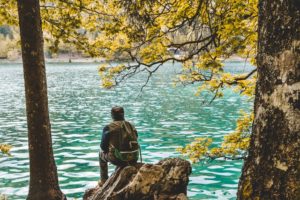
It is well known and mentioned repeatedly on The Village Prepper, you can only survive three days without water, less if you are extremely active or in a dry climate. If you are without water for a couple of days, you can become incapacitated, and finding water at that point could be impossible.
Dehydration can cause you to make mistakes you wouldn’t normally make. Finding water should be on the top of your list so find it quick and don’t let it get to a dangerous point.
Here is a list of common symptoms of dehydration:
- Dark urine with a very strong odor
- Low urine flow
- Fatigue
- Emotional instability and foggy mental state
- Loss of skin elasticity
- Channel down center of tongue
- Inability to perspire (if you stop sweating you are in trouble)
- High body temperatures
- Hallucinations
- Nausea
- Rapid heart rate
Finding Water in Urban Areas
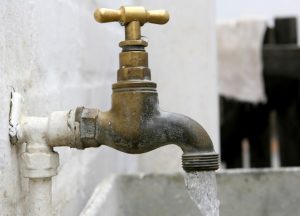
Finding water in the city can be extremely difficult. Almost every source of water you are likely to run into will be contaminated to some degree.
But you are not completely screwed, there are ways to find water that you can filter in an urban environment.
- Water Heaters and Pipes
- Garden Hoses & Sprinkler Systems
- Toilet Water (toilet tank not the bowl)
- Swimming Pools (residential and commercial)
- Golf Courses and Parks
- Public Fountains in Warm Months
- Do It Yourself Car Wash (watch for excessive soap in the lines)
- Vending Machines and Abandoned Office Water Coolers
Finding Water in the Wilderness
Finding water in the wilderness is not easy but it is more likely the water will be cleaner. Here are a few ways to get water when you are stranded or lost in the wild.
- Rain Collection
- Rivers, Lakes, Streams
- Fruits and Vegetation
- Morning Dew on Leaves and Tarps
- Tree Forks and Rock Crevices
- Follow Ants
Filtering Water in a SHTF Situation
Once you find water, it WILL need to be filtered. Always carry a small portable water filter such as the Sawyer Water Filter System or something similar. See our article on the best water filters.
You can also boil water to make it drinkable and that is another reason starting a fire is so important.
In addition to the above suggestions, I recommend you always carry a water bottle on you. A quality stainless steel water bottle can really come in handy in a disaster.
Wilderness Navigation Skills
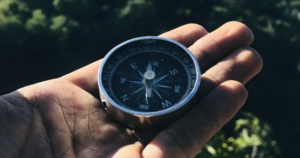
If you find yourself having to bug out, get home or lost while enjoying the outdoors, you need to know some basic ways of navigating.
One of the best tools you can carry for navigation in the woods or even the city is a quality compass. Although you think you know your area pretty well, in a high-stress situation, you can easily become disoriented.
A lot of what is involved in navigation is simply being aware of your surroundings at all times. Keep an eye out for clues as to the direction you are heading and things you may have passed before.
If you find yourself lost, it is important to stop, catch your breath, calm yourself down and get your bearings. It is easy to let the situation get the best of you and panic, making the situation much worse.
How to Find Direction in the Wilderness
The first thing to do is try and locate North:
- Use a compass
- Look for moss on trees, it usually grows on the north side
- Look for spider webs, spiders tend to build them on the south sides of trees
- Watch the sun
- Trees will have more and fuller leaf coverage on the southern side
Navigation may seem like it is a no-brainer. You have been traveling these areas for years and think you know it well. It is still a good idea to have a good map and a compass. Better to have it and not need it than to need it and not have it.
Make sure to visit the areas on the map that you may have to cover. Things are much different in real life than they are on a map or Google maps.
Knowing Your Wild Edibles

This is another important skill to have and it’s is fun to learn as well. There is no way I can teach this skill here because this varies so much by location.
My biggest advice for this is to get a great book on identifying wild edibles in your area. Get one that is easily carried in your backpack and focuses on your area.
This can be a fun skill to learn but use extreme caution when locating and eating wild edibles. Make absolutely certain that the plant you are collecting is the exact plant you see in your book. Get a book with clear, colorful, and large pictures so you can compare them.
Some of the plants you find can also have medicinal qualities as well so finding a good book on medicinal plants is also recommended.
This skill can come in handy when fishing and hunting are slow or not an option. It is unlikely foraging on wild edible plants can sustain you long term, but it may just keep you alive long enough to get out of danger.
Remember, finding what plants to NOT eat is just as important as finding plants that are edible.
Communications in a SHTF Situation
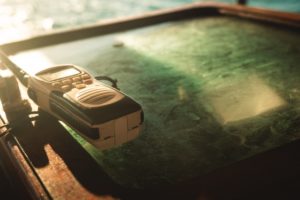
Communication almost didn’t make my list but after some thought, if you have good communication, it could save you a lot of headaches and save you in a life-threatening situation.
Here are a few forms of communication
- Ham Radio
- FMR Radios
- Cell Phone
- Signal Mirror
- Personal Locator Beacon (PLB)
- Satellite Phone
- Firearms (this method has been around for a long time, fire shots to notify rescue)
NOTE: Remember to always let someone know where you are going, how long you will be gone and the path you plan to take.
Be sure to read my article on backup communication is an SHTF situation.
Conclusion
I know this is only six of a zillion skills that one should learn for survival, but these are the skills I thought most important.
If you only take one thing away from this article it should be that practice is what makes a skill a useful skill. If you find yourself needing to use these skills in an SHTF or disaster situation, you can bet the stress will make things much more difficult.